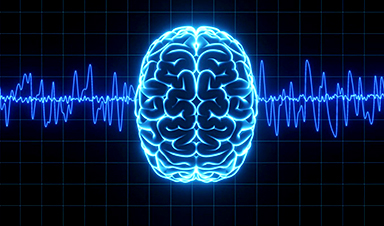Yale scientists traced gamma brain waves to thalamus-cortex interactions. The discovery could reveal how brain rhythms shape perception and disease.
For more than a century, scientists have observed rhythmic waves of synchronized neuronal activity in the brain. Now, for the first time, researchers at Yale University have pinpointed where a specific type of this activity—known as gamma waves—originates and have linked it directly to behavior.
Through the development of a highly precise new method for measuring brain activity, the team overcame long-standing technical barriers that had prevented a clear understanding of how these oscillations contribute to information processing and behavioral control.
The findings were recently published in the journal Nature.
Following an unexpected discovery
Jessica Cardin, PhD, the Gordon M. Shepherd Professor of Neuroscience at Yale School of Medicine and senior author of the study, did not initially plan to revisit this topic. As a postdoctoral researcher, she had previously shown that gamma waves could be artificially induced in the brain, but she considered the "perfect experiment" to test their function nearly impossible.
In neuroscience, determining the role of an element such as a gene, protein, or neural rhythm typically involves disrupting it to observe the consequences. However, that approach does not work for brain oscillations.

That changed when one of her postdoctoral fellows, Quentin Perrenoud, PhD—the study's first author—presented intriguing data he had gathered while tracking how information moved through the brain during a behavioral task. The results suggested that gamma waves might be predicting behavior. Encouraged by the evidence, the team pursued the lead, ultimately uncovering findings that challenge long-held assumptions about how these brain rhythms arise.
"It's not quite a perfect experiment, but it's a lot closer to a perfect experiment than we've ever been able to get," says Cardin.
Gamma activity emerges from interactions between the thalamus and cortex
To carry out the study, the research team created a new, highly detailed method to measure gamma waves. These brain oscillations were once believed to be continuous, resembling the smooth, unbroken rise and fall of a sound wave. However, more recent evidence suggests that gamma activity does not occur in a steady flow but instead appears in short, intermittent bursts.
Building on this concept, the researchers recorded neuronal activity at 16 distinct locations within the visual cortex—the region of the brain responsible for processing visual information. This allowed them to capture both the spatial and temporal dynamics of gamma activity with greater precision. They then separated the recordings into individual gamma events, each representing a single peak-to-trough-to-peak cycle of a wave.
If gamma activity truly behaved like a continuous oscillation, combining all these discrete events would produce a seamless wave pattern moving across the recorded brain regions.
"But it turned out that these events can happen together, or in little bursts, or all by themselves," says Cardin. "They're not happening in a long sequence."
This approach, which the researchers have named CBASS (Clustering Band-limited Activity by State and Spectrotemporal feature), offers a much greater level of sensitivity than other techniques for studying gamma activity.
"It allows us to get very fine timing and to clearly identify these short events, which means we can map them with great precision during interesting moments, like when an animal is making a decision," says Cardin. "That means we can map the events in the brain to the behavior of the animal with more precision than we've ever had before."
When it comes to where gamma activity arises, there have been two schools of thought. A lot of the available evidence has supported the idea that gamma activity is generated in the cortex. But some research has suggested the cortex inherits the activity from elsewhere in the brain—for example, from the thalamus, which sends a lot of sensory and motor information to the cortex.
"With this new method, our data suggest both are wrong, and that this activity arises due to an interaction between the thalamus and the cortex. Gamma arises dynamically as the thalamus sends input to the cortex, where it's then amplified," says Cardin.
Disrupting signals from the thalamus affects behavior
The precision of CBASS also gives the researchers that much-sought-after ability to break the system, to disrupt these patterns of activity in a way that doesn't affect the entire brain.
To do that, the researchers first trained mice on a visual task wherein the mice received a reward if they licked a waterspout only when a certain visual stimulus was shown. Then, the researchers disrupted the signals that the thalamus sent to the cortex, which, in turn, disrupted the gamma activity in the cortex.
This gamma disruption caused the mice to perform much worse on the visual task. So then the researchers took the opposite approach and artificially initiated gamma activity.
"We recorded gamma activity from mice who were detecting the visual stimulus and then played it back into the brain of other mice. And when we did that, it tricked the mice into thinking they had detected a stimulus," says Cardin.
Together, the findings indicate that gamma activity in the cortex supports the integration of visual information and is involved in the behavioral responses that emerge from that integration. And this is important information to have, as studies have shown that this type of activity is altered in people with neurodevelopmental disorders, schizophrenia, and bipolar disorder, as well as neurodegenerative diseases.
Future directions: linking gamma activity to disease and cognition
Cardin's lab is now looking into whether gamma activity in the cortex could be used as an early biomarker for conditions like Alzheimer's disease. Acetylcholine and norepinephrine, key signaling molecules in the thalamus and cortex, are tightly linked to cognition and lost in neurodegenerative diseases. These neuromodulatory signals are known to regulate the pattern of brain activity.
"We're starting to look at how neuromodulatory signals are associated with these gamma events and we'll apply our tools to better understand the sequence of things that go wrong in neurodegeneration," says Cardin. "This could lead to an interpretable early biomarker for Alzheimer's disease that is easily accessible in humans."
Reference: "Flexible perceptual encoding by discrete gamma events" by Quentin Perrenoud, Antonio H. de O. Fonseca, Austin Airhart, James Bonanno, Rong Mao and Jessica A. Cardin, 8 October 2025, Nature.
DOI: 10.1038/s41586-025-09604-9
The researched reported in this news article was supported by the National Institutes of Health (awards EY022951, EY035127, MH113852, and EY026878) and Yale University. The content is solely the responsibility of the authors and does not necessarily represent the official views of the National Institutes of Health. Additional support was provided by the McKnight Foundation, the Kavli Institute of Neuroscience, and the Brain and Behavior Research Foundation.
News
Older chemical libraries show promise for fighting resistant strains of COVID-19 virus
SARS‑CoV‑2, the virus that causes COVID-19, continues to mutate, with some newer strains becoming less responsive to current antiviral treatments like Paxlovid. Now, University of California San Diego scientists and an international team of [...]
Lower doses of immunotherapy for skin cancer give better results, study suggests
According to a new study, lower doses of approved immunotherapy for malignant melanoma can give better results against tumors, while reducing side effects. This is reported by researchers at Karolinska Institutet in the Journal of the National [...]
Researchers highlight five pathways through which microplastics can harm the brain
Microplastics could be fueling neurodegenerative diseases like Alzheimer's and Parkinson's, with a new study highlighting five ways microplastics can trigger inflammation and damage in the brain. More than 57 million people live with dementia, [...]
Tiny Metal Nanodots Obliterate Cancer Cells While Largely Sparing Healthy Tissue
Scientists have developed tiny metal-oxide particles that push cancer cells past their stress limits while sparing healthy tissue. An international team led by RMIT University has developed tiny particles called nanodots, crafted from a metallic compound, [...]
Gold Nanoclusters Could Supercharge Quantum Computers
Researchers found that gold “super atoms” can behave like the atoms in top-tier quantum systems—only far easier to scale. These tiny clusters can be customized at the molecular level, offering a powerful, tunable foundation [...]
A single shot of HPV vaccine may be enough to fight cervical cancer, study finds
WASHINGTON -- A single HPV vaccination appears just as effective as two doses at preventing the viral infection that causes cervical cancer, researchers reported Wednesday. HPV, or human papillomavirus, is very common and spread [...]
New technique overcomes technological barrier in 3D brain imaging
Scientists at the Swiss Light Source SLS have succeeded in mapping a piece of brain tissue in 3D at unprecedented resolution using X-rays, non-destructively. The breakthrough overcomes a long-standing technological barrier that had limited [...]
Scientists Uncover Hidden Blood Pattern in Long COVID
Researchers found persistent microclot and NET structures in Long COVID blood that may explain long-lasting symptoms. Researchers examining Long COVID have identified a structural connection between circulating microclots and neutrophil extracellular traps (NETs). The [...]
This Cellular Trick Helps Cancer Spread, but Could Also Stop It
Groups of normal cbiells can sense far into their surroundings, helping explain cancer cell migration. Understanding this ability could lead to new ways to limit tumor spread. The tale of the princess and the [...]
New mRNA therapy targets drug-resistant pneumonia
Bacteria that multiply on surfaces are a major headache in health care when they gain a foothold on, for example, implants or in catheters. Researchers at Chalmers University of Technology in Sweden have found [...]
Current Heart Health Guidelines Are Failing To Catch a Deadly Genetic Killer
New research reveals that standard screening misses most people with a common inherited cholesterol disorder. A Mayo Clinic study reports that current genetic screening guidelines overlook most people who have familial hypercholesterolemia, an inherited disorder that [...]
Scientists Identify the Evolutionary “Purpose” of Consciousness
Summary: Researchers at Ruhr University Bochum explore why consciousness evolved and why different species developed it in distinct ways. By comparing humans with birds, they show that complex awareness may arise through different neural architectures yet [...]
Novel mRNA therapy curbs antibiotic-resistant infections in preclinical lung models
Researchers at the Icahn School of Medicine at Mount Sinai and collaborators have reported early success with a novel mRNA-based therapy designed to combat antibiotic-resistant bacteria. The findings, published in Nature Biotechnology, show that in [...]
New skin-permeable polymer delivers insulin without needles
A breakthrough zwitterionic polymer slips through the skin’s toughest barriers, carrying insulin deep into tissue and normalizing blood sugar, offering patients a painless alternative to daily injections. A recent study published in the journal Nature examines [...]
Multifunctional Nanogels: A Breakthrough in Antibacterial Strategies
Antibiotic resistance is a growing concern - from human health to crop survival. A new study successfully uses nanogels to target and almost entirely inhibit the bacteria P. Aeruginosa. Recently published in Angewandte Chemie, the study [...]
Nanoflowers rejuvenate old and damaged human cells by replacing their mitochondria
Biomedical researchers at Texas A&M University may have discovered a way to stop or even reverse the decline of cellular energy production—a finding that could have revolutionary effects across medicine. Dr. Akhilesh K. Gaharwar [...]





















